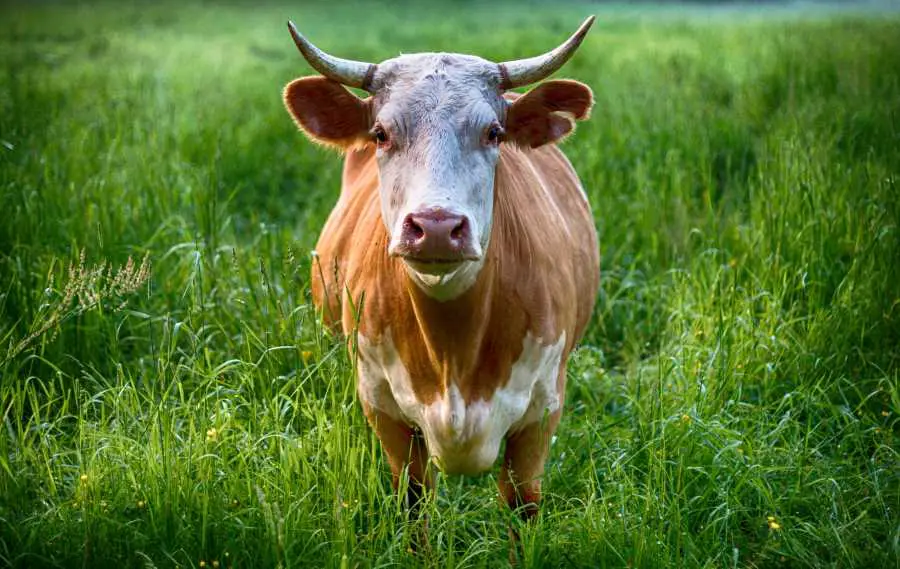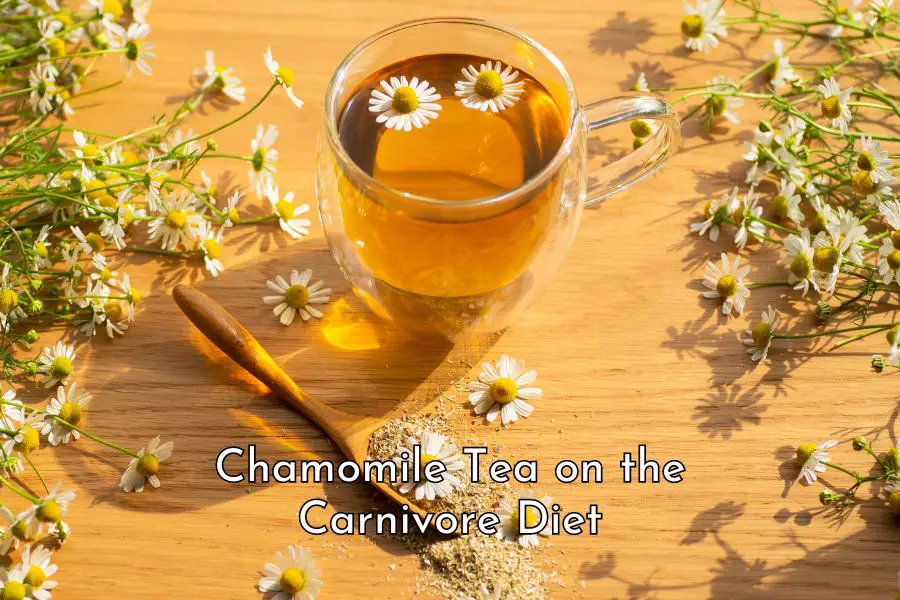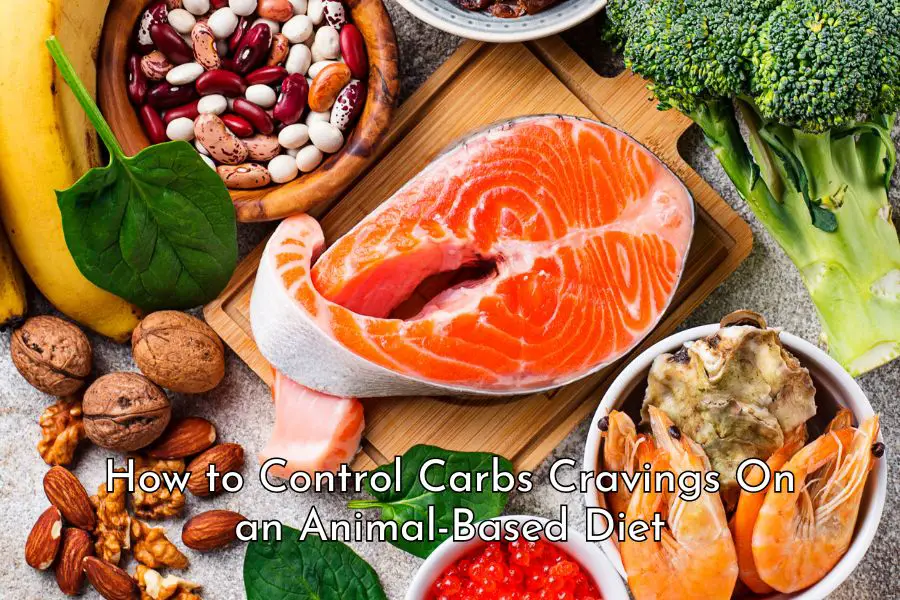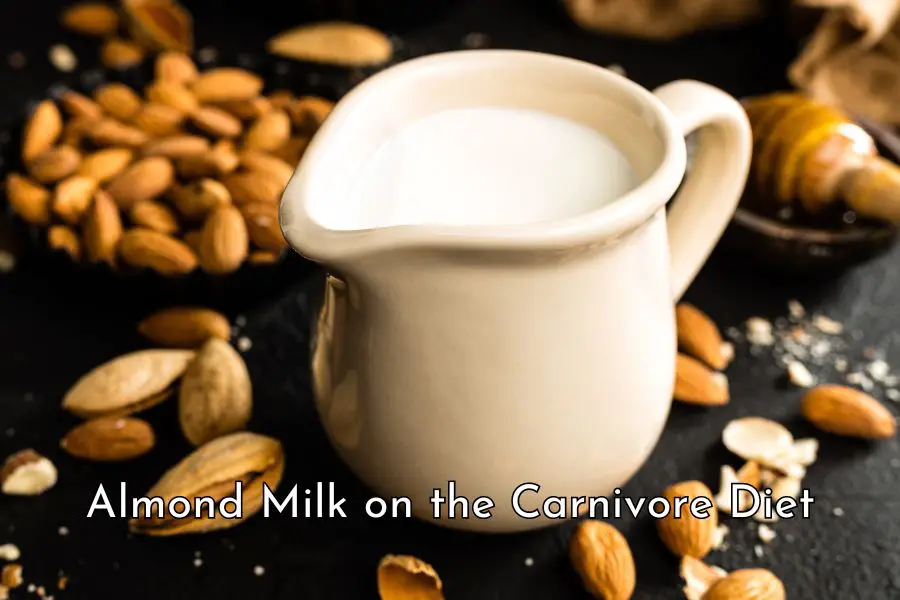Grass-fed beef is from cattle that have been fed a species-appropriate diet and has a better nutritional profile than grain-fed beef. But is the difference really worth paying for?
This in-depth post will look at how cattle are raised differently to produce grass-fed and grain-fed beef and the consequential differences in their nutritional profiles and contaminants such as antimicrobial, growth hormone, and pesticide residues.
How Cattle Is Raised for Beef?
Cattle raised for beef, whether it’s grass-fed or grain-fed, will start their lives on pasture.
Newborn calves are raised on pasture with their mothers and weaned after 6 to 9 months. They will then spend 6 to 12 months more on pasture grazing. [1]
If they are intended for grass-fed and grain-finished beef, they will then be sent to feedlots where they are fed a grain-based diet (corn, soy, grains, and industry byproducts) to accelerate weight gain. They will generally be kept in confinement and spend about 4 to 6 months at the feedlots to reach slaughter weight. [2, 3]
If they are intended for 100% grass-fed, they will spend their entire lives on pasture. However, they may be given supplement feed (dry hay or haylage) during the winter months. [4]
Grass-fed cattle generally take longer (around 24 to 30 months) to reach slaughter weight compared to grain-fed cattle (around 18 months). [5]
Cattle raised for organic beef is fed an organic diet and free from synthetic hormone and antibiotic treatments, however, their diet may not be 100% grass and can include, for example, organic corn, soy, and grains.
In the following section, we will look at the differences between grass-fed and grain-fed beef in terms of nutritional content and the levels of hormones, pesticides, antibiotics and other contaminants.
Differences Between Grass-fed and Grain-fed Beef
There is no major difference between grass-fed and grain-fed beef in terms of essential nutrients. However, grass-fed beef does have a slightly better fatty acid profile and antioxidant contents.
With regard to antimicrobial, hormone and pesticide residues in meat, there is no evidence suggesting that grain-fed beef is more likely to contain residues exceeding the maximum limits than grass-fed beef.
1. Differences in essential nutrients
Apart from the difference in fatty acid profiles, which we will look at in the next section, there is no significant difference in essential nutrients between grass-fed and grain-fed beef.
Grass-fed beef is generally leaner with a higher protein and lower fat content but its levels of vitamins and minerals are similar to those of grain-fed beef.
Both are great sources of good quality proteins, B vitamins (B3, B6, B12), iron, selenium, zinc, and phosphorus. They also provide a small amount of many other vitamins and minerals. [6, 7, 8]
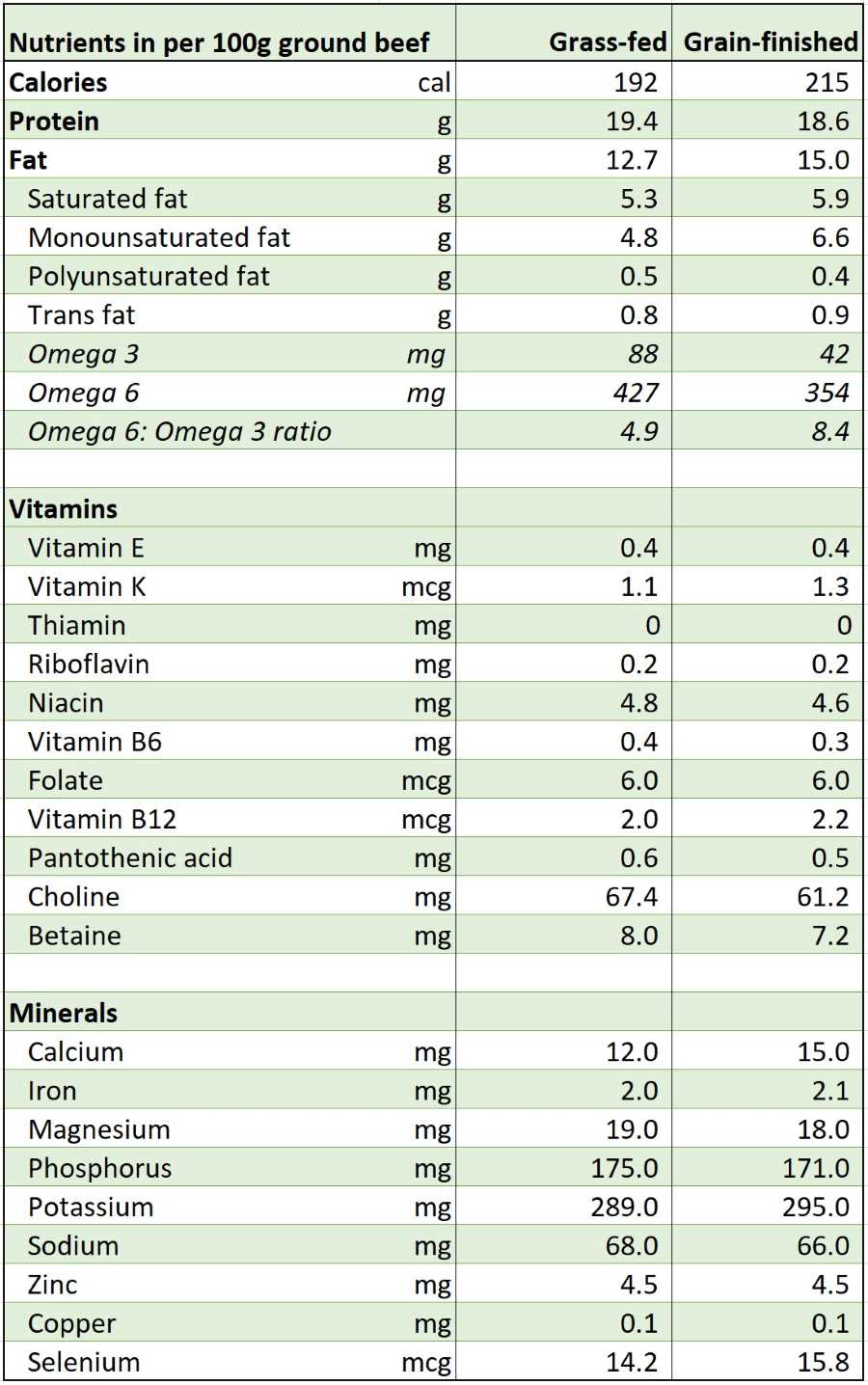
In addition, beef, grain-fed or grass-fed, is also an abundant source of many beneficial bioactive compounds such as taurine, carnitine, conjugated linoleic acid, endogenous antioxidants (CoQ10, glutathione, lipoic acid, spermine, carnosine, and anserine), and creatine. [9]
2. Differences in fatty acid profiles and antioxidant content
Grass-fed beef has a more favorable fatty acid profile and antioxidant content than grain-fed beef.
In particular: [10, 11, 12, 13, 14, 15, 16, 17, 18, 19]
- Grass-fed beef is generally lower in total fat compared to grain-fed beef. For example, U.S. evidence indicates that grass-fed beef has 1.6 to 4.1 g less fat per 100 g meat than grain-fed beef
- Grass-fed beef is generally lower in monounsaturated fat compared to grain-fed beef
- Grass-fed beef has been found to have 2 to 5 times more omega-3 fatty acids than grain-fed beef. The plasma omega-3 fatty acid concentration of people consuming grass-fed beef has been found to be higher than those consuming grain-fed beef
- Grass-fed beef has a lower omega-6 to omega-3 ratio than grain-fed beef. Grass-fed beef has been found to have an omega-6 to omega-3 ratio in the range of 1.4 to 3.7 compared to the range of 3.0 to 10.4 in grain-fed beef
- Grass-fed beef has more conjugated linoleic acid which has been found to promote fat loss and improve body composition and offer other health benefits
- Grass-fed beef has more vitamins A, C, and E as well as cancer-fighting antioxidants such as glutathione. For example, one study has found that grass-fed beef has 2 times more vitamin E, 7.5 times more beta-carotene (precursor to vitamin A), and 1.6 times more vitamin C than grain-fed beef.
Although the overall fatty acid profile of grain-fed beef is not as good as that of grass-fed beef, it is still a lot better than those of pork and poultry.
Because cattle are monogastric animals, even when they are fed corn, soy, and grains at feedlots, they are still able to convert the polyunsaturated fats in their feed to saturated fats. As a result, only around 3-4% of beef fats are PUFAs compared to 15 to 20% in pork and poultry. [20, 21]
Furthermore, grain-fed beef’s omega 6 to omega 3 ratio is higher than that of grass-fed beef but is still very low and a lot closer to the desired ratio of one to one compared to pork and poultry. [22, 23, 24]
3. Differences in antimicrobials, hormones, and pesticides
A major concern amongst health-conscious consumers with regard to grain-fed beef is that it may contain an unhealthy level of hormones, pesticides, and other contaminants.
However, a review of available evidence shows that there is not a significant difference between grass-fed and grain-fed beef with regard to the levels of those contaminants contained therein.
Antibiotics and other antimicrobials
Conventionally-raised cattle are fed a grain-based diet at the feedlot stage to aggressively accelerate weight gain before slaughter. As a result, some feedlot cattle may develop liver abscesses which adversely impact cattle health, farmers’ profit, and, ultimately, consumers. [25]
To control liver abscesses, cattle are usually given a low-dose antibiotics in their feed. Five commonly used antibiotics are bacitracin methylene disalicylate, chlortetracycline, oxytetracycline, tylosin, and virginiamycin. [26, 27]
Poor living conditions also adversely affect cattle health and lead to more use of drugs to treat diseases.
Cattle at feedlots are generally kept in large outdoor pens on a soil surface and may contain from 2,000 to over 100,000 cattle. They may have to live in muddy conditions during rainy seasons, suffer from heat stress and respiratory problems due to dust during hot months, or endure long transport. [28]
Other health problems arising from their unnatural diet and living conditions are acidosis, polio, and pneumonia and antimicrobials and other drugs are required to treat them. [29, 30, 31, 32]
Hormones
Beef cattle are also given hormones for reasons that is often not clear to consumers.
When bull calves are castrated to make them more docile in feedlots or on pasture, they lose some of their endogenously produced hormones, hence their performance is affected and they tend to gain more fat than muscle. [33]
They are therefore given hormones via pellets or implants placed under the skin on the back side of their ears. The implants dissolve slowly and, by the time their meat reaches consumers, the implants would have been completely dissolved and metabolized. [34, 35]
The hormones given to cattle are naturally-occurring hormones such as estrogen, progesterone, and testosterone which are necessary for normal development, growth, and reproduction. Synthetic versions of the natural hormones are also given but all hormones are required FDA approvals before being administered to cattle. [36]
According to the USDA, the amounts of hormones administered to cattle are extremely low compared to their production in humans. [37]
A young boy would need to eat more than 16 pounds of beef raised using synthetic estradiol daily in order to produce a one percent increase in his production of this hormone.
About one pound of beef raised using synthetic estradiol contains about 15,000 times less of this hormone than the amount produced daily by the average man and about nine million times less than the amount produced by a pregnant woman.
Pesticides
Unless the cattle is intended for organic beef, in which case they will be fed an organic diet, grain-fed beef is likely to contain pesticide residues because they are fed grains conventionally grown, generally with the widespread use of synthetic pesticides, herbicides, and fertilizers.
However, organic farming does use organic pesticides although to a lesser extent than conventional farming and organic pesticides can be just as dangerous as synthetic pesticides. [38, 39, 40, 41]
Furthermore, perhaps, too much emphasis seems to have been put on man-made pesticides. Natural pesticides that plant produces to defend themselves are just as dangerous as man-made ones. Common plant food has been found to contain thousands of times more natural pesticides than synthetic pesticides. [42]
Levels of antimicrobial, hormone, and pesticide residues in grass-fed vs grain-fed beef
Surprisingly, given the major difference between how grass-fed and grain-fed beef cattle are raised, available evidence indicates that the difference in the likelihood that contaminant residues reach harmful levels between them is negligible.
The table below (reproduced from a Beef Research study) shows that, based on three studies, there was no difference in the likelihood of violative residues occurring in grain-fed, grass-fed, and organic beef.
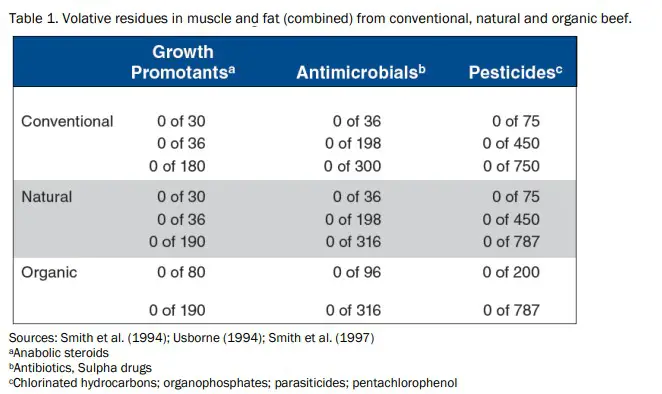
In simple terms, all three studies found that conventionally-raised beef was no more likely to violate maximum residue limits than pasture-raised or organic beef.
With regard to growth hormone residues in beef, even with steers given hormones, their level of the hormone estrogen is still negligible compared to other foods, especially plant food.
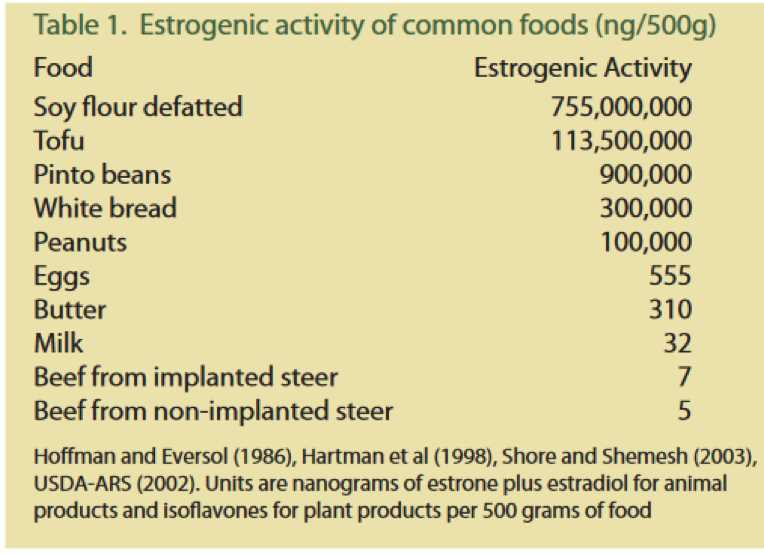
Consuming meat from cattle that have been injected with growth hormones sounds very unhealthy, regardless of the level of residues.
However, the American Meat Institute notes that “beef from an uncastrated bull not administered hormones contains testosterone levels more than 10 times higher than the amount in beef from a steer (which is castrated) that has received hormones for growth promotion“. [43]
In the US, a National Residue Program has been established since 1976 to test and monitor veterinary drug, pesticide, and environmental contaminant residues in domestic and imported meat, poultry, and egg products. The percentage of violations so far has been found to be extremely low.
For example, in 2008, over 130,000 samples were taken for bovine animals. The overall percentage of violations across all production classes of bovine animals was only 0.89%, i.e. 99% of all beef samples meet safety requirements with regard to contaminants.
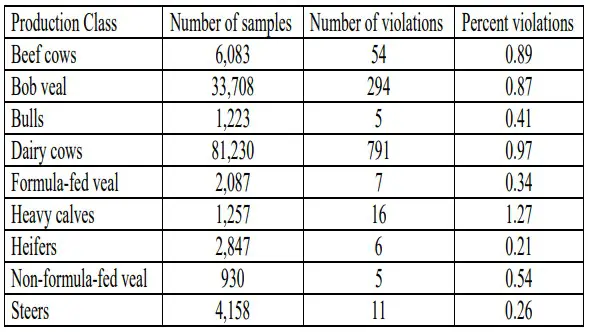
Conclusion
Cattle that spend their entire lives living in their natural environment and eating a species-appropriate diet will be more healthy and produce more nutritious beef that is less likely to be contaminated with hormones, pesticides, herbicides, and antimicrobials.
If you can afford grass-fed beef on your carnivore diet, it’s clear that you should choose pasture-raised or grass-fed beef.
However, even grain-fed beef is still a super nutritious food and available evidence indicates that there is no substantial difference in the likelihood of grass-fed beef containing harmful levels of contaminants than grain-fed or organic beef.
As Ames et al (1990) point out, concerns about ingesting synthetic chemicals from our diet seem to be have been blown out of proportion when “99.99% (by weight) of the pesticides in the American diet are chemicals that plants produce to defend themselves“. [44]
If you can’t afford grass-fed beef, rest assured that you are still giving your body one of the most nutrient-dense foods ever by dining on just grain-fed beef on the carnivore diet.
Here’s what Joe Anderson, a man who has been on the carnivore diet for over 20 years, had to say about his experience eating grain-fed beef only.
Early on we ate grass-fed exclusively. We were pain-in-the-ass, religious zealots about it until we realized that we felt better (MUCH better) eating grass-raised, grain-finished good ol’ fashioned grocery store meat from our local Kroger or Winn-Dixie.
Goodbye frozen bricks of way too lean beef, goodbye toe cramps and leg cramps in the middle of the night, goodbye restless nights, goodbye to our air of superiority as we attempted to savor the flavor of a cut of meat from an obviously undernourished animal.
Grain is from a grass. When it is left to grow naturally, it goes to seed resembling a stalk of wheat. This seed head contains nutrition that “grass-fed” animals never see. Grass-fed farmers typically do not let their fields “go to seed”. A field of grass that is allowed to go to seed contains as many as 20 different species of grass and plant life, while a field prevented from going to seed will be lucky to have 10. It was a huge monkey off our back to stop eating grass-fed/pasture-raised/organic meat!
Joe Anderson
Other posts you might be interested in:
Disclaimer: The information in this post is for reference purposes only and not intended to constitute or replace professional medical advice. Please consult a qualified medical professional before making any changes to your diet or lifestyle.
Photo credit: Pixabay

